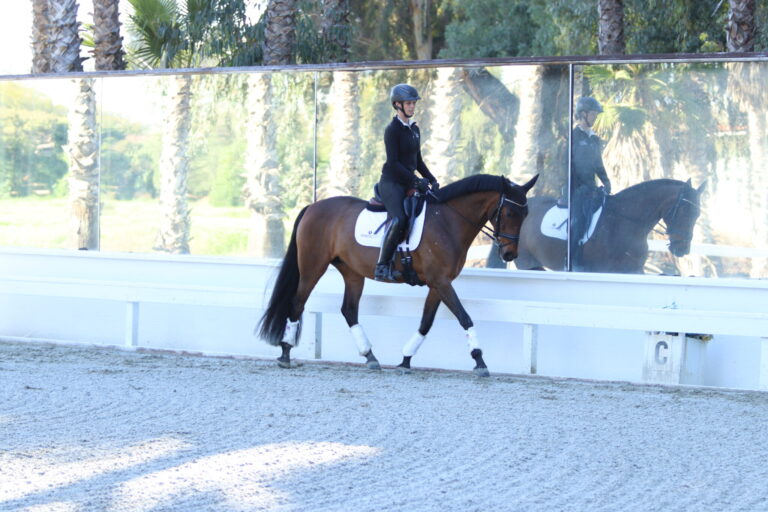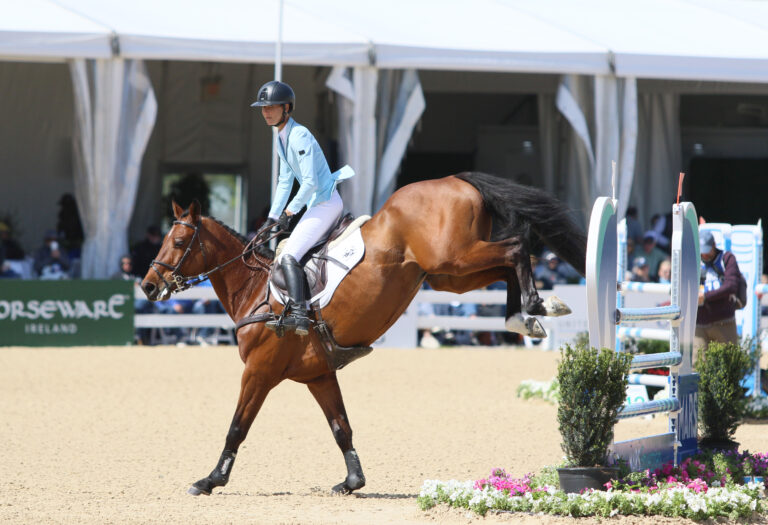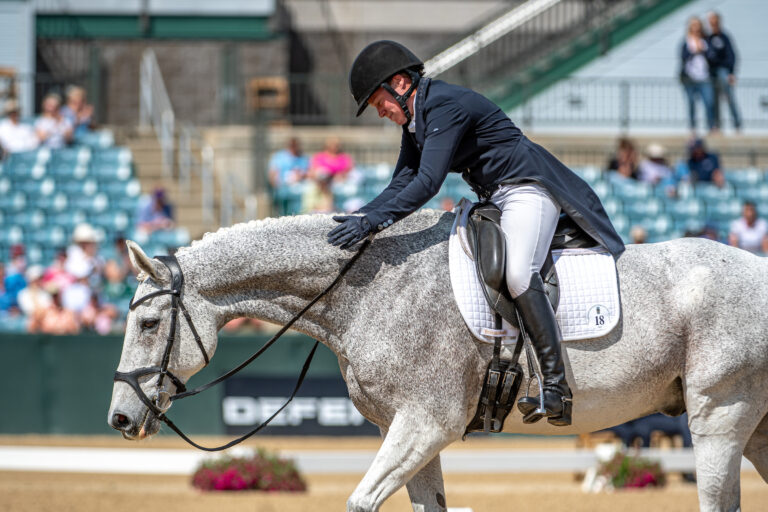In this gymnastic, you will position raised rails both before and after two crossrails in an hourglass pattern. The raised rails sit four to five strides out from the crossrails, angled left and right as well as straight ahead so you can vary your path following the gymnastic.
The hourglass offers plenty of flexibility—you’re limited only by your imagination. For example, make the two center crossrails a one-stride one day and a bounce another—or use a combination of the two with three crossrails.
For optimal results, I incorporate transitions between gaits as part of my gymnastic scheme. Practicing transitions can never be overdone because they help balance your horse and give his stride adjustability. In this exercise, you will ask for numerous transitions and adjustments to enhance your horse’s balance and athleticism in front of, over and after each rail or crossrail. Lengthening and shortening strides in this fashion prepares him for more advanced work. He will also be more prone to stay with you mentally and wait for your direction when he lands.
Most horses have more difficulty slowing down and shortening strides than moving forward and lengthening them because they naturally carry more weight on the forehand and must shift it back over their haunches in downward transitions. Fences intensify this challenge because the thrust of a horse’s jump transfers tremendous weight onto his forehand as he lands. When you keep the distances short inside the raised rails and the crossrails, you encourage not only a steadier, balanced approach but a slower, softer landing.
Riding the countless transitions in these exercises will teach your horse how to rebalance his weight to stay light on the landing, helping you regain control. You must recover your own position as quickly as possible to reinforce and contribute to his rebalancing effort. If you do nothing and he focuses instead on the next fence and takes over and braces against you, change his mind by transitioning down to the trot or even to the walk and then begin again. When he is thinking with you, not for you, he will be easier to manage once you are cantering an entire course.
Benefits
This exercise:
• requires the horse to think about the placement of his feet,
• improves the horse’s accuracy off the ground,
• encourages cleverness between obstacles,
• establishes a better jumping style,
• improves balance and rideability,
• strengthens the horse’s attentiveness to the rider’s directions,
• encourages a steadier, balanced approach and a slower, softer landing.
Who Can Do It
Anyone can practice this exercise with any horse. For an easier version, you can use rails in place of crossrails.
Setup
This exercise should be set up so it can be jumped in either direction. Study the diagram below. Build an 18- to 21-foot one-stride or a 10- to 12-foot bounce using two crossrails on the centerline with ground lines on either side. Ground lines further improve balance and adjustability because they will shorten the stride in between the jumps even more, making the distances tighter than those typically used on a course.
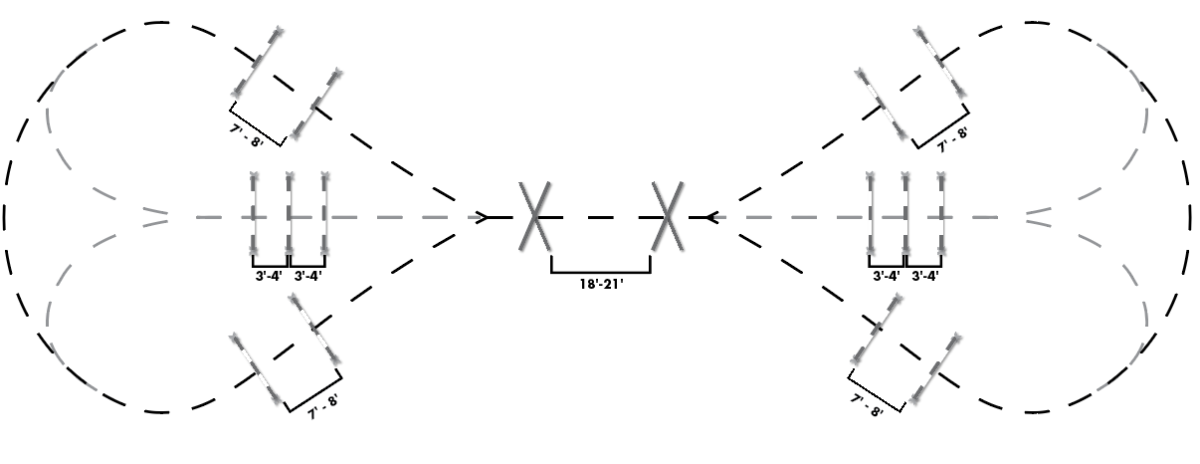
Courtesy, “Riding with Life: Lessons from the Horse”
Place three rails raised 6 inches at distances 3 to 4 feet apart on a straight line four to five strides before and after the crossrails. Since you will be transitioning to trot to ride over these rails, the exact measurement of the line is not important since it is not a related distance, but it can be set at approximately 60 feet or whatever space allows. This series of closely-placed rails requires the horse to think about the placement of his feet and encourages the downward trot transition between the crossrails and the direct line to the raised rails.
Then about four or five strides on the left and right angles before and after the two crossrails, place two raised rails 7 to 8 feet apart. Set the height of the raised rails at 6 or 12 inches. You can approach both heights at the trot or canter. If the rails are 6 inches, you have the option of trotting over both rails. If the rails are 12 inches, your horse should bounce them from either the trot or canter.
How to Ride the Exercise
1. First, warm up your horse at the walk, trot and canter. This exercise can be part of your continued warm up on the flat with a few rails and small jumps in the way. It is merely an exercise in adjustability.
2. Begin trotting to any set of raised rails. If your horse lands cantering, continue to canter or transition to trot and ride to the crossrails on the centerline. Upon landing, transition back to trot or continue at a soft canter.
3. After the crossrails, trot straight over the three raised rails. Turn left or right and trot or canter over one set of raised poles and ride the bending line to the crossrails either at trot or canter. Next, go over the bending line first, then return on a straight line.
4. Constantly change the gait and pattern of this exercise to keep your horse soft, supple and tuned in to you. He must not only follow a feel but also focus on the line you choose and place his feet correctly over the raised rails before and after the jumps.
5. As you practice, stay aware of your horse’s straightness. Aim for the center of each rail or crossrail and be disciplined about landing and riding away from the obstacles on a straight line. Even if you have curved to the left or right, ride out the straight line following the bend to keep your horse honest and straight between your aids.
About Melanie Smith Taylor
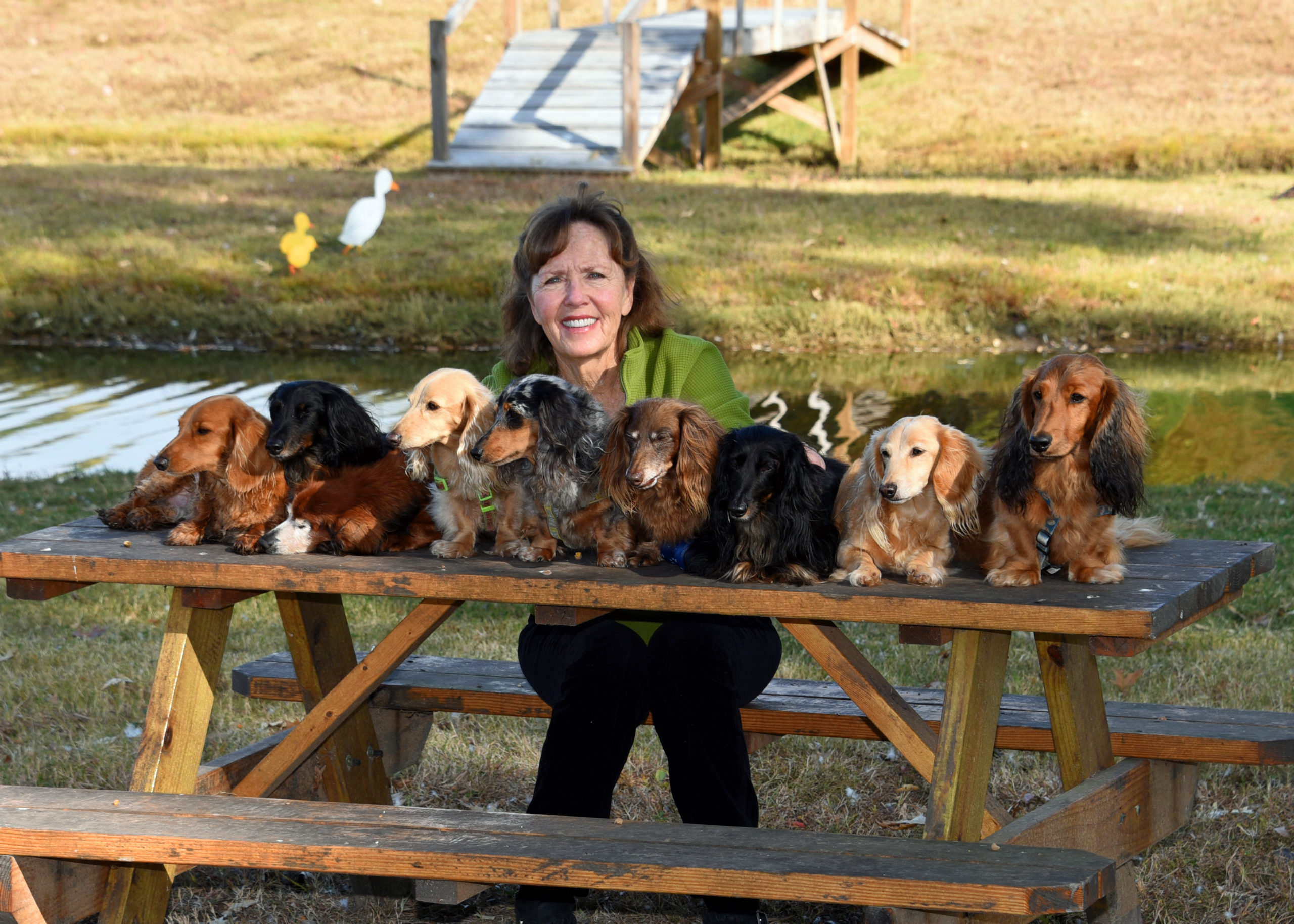
Melanie Smith Taylor is an internationally recognized competitor and trainer with many accolades in the sport of show jumping. Melanie was part of the gold-medal-winning team at the 1979 Pan American Games in Puerto Rico, won the individual bronze medal with her beloved horse Calypso at the “Alternate Olympics” in 1980 and won a team gold medal at the Los Angeles Olympics in 1984, also with Calypso. She won the World Cup Final in 1982 and placed second in 1980. Melanie retired from competition in 1987 but continues to be active in equestrian sport. She is a television broadcaster, course designer, judge, clinician and trains young riders. Melanie is based at Wildwood Farm in Germantown, Tennessee.
This article originally appeared in the Winter 2019 issue of Practical Horseman and is adapted from “Riding With Life: Lessons from the Horse” by Melanie Smith Taylor and Jamie Caton, which can be purchased at Eclectic-Horseman.com and Amazon.com. Readers can get a signed copy by directly contacting Melanie through her website at MelanieSmithTaylor.com.





